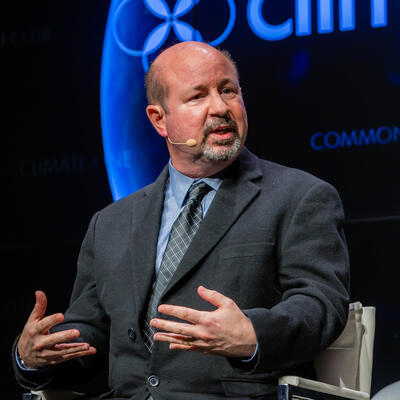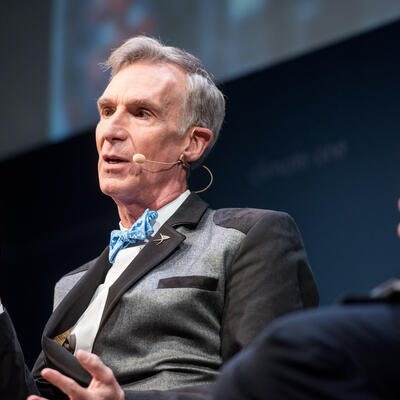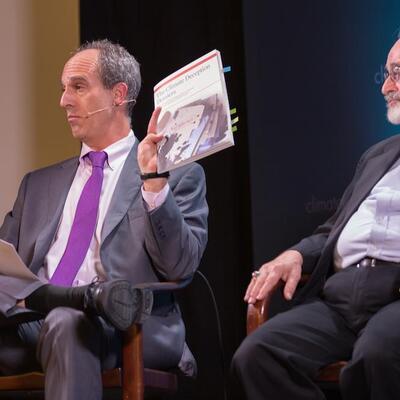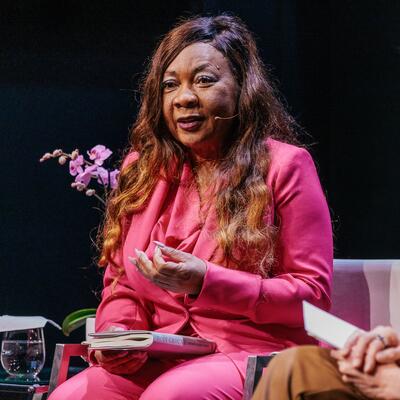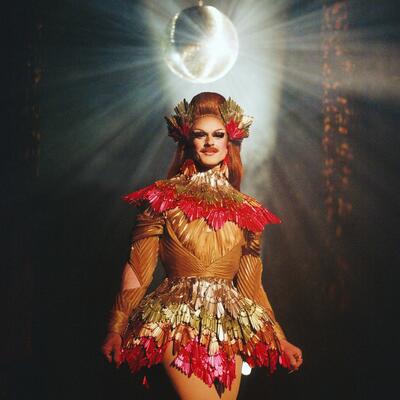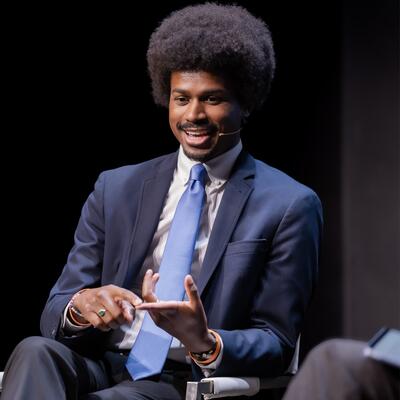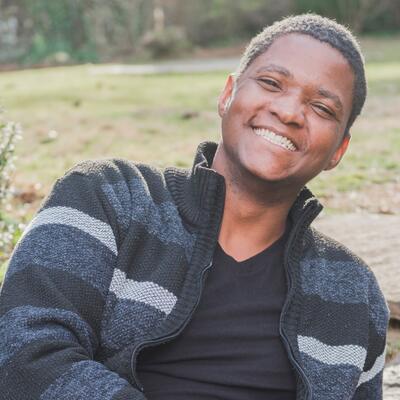
Pairing Scientists with Community Advocates
Guests
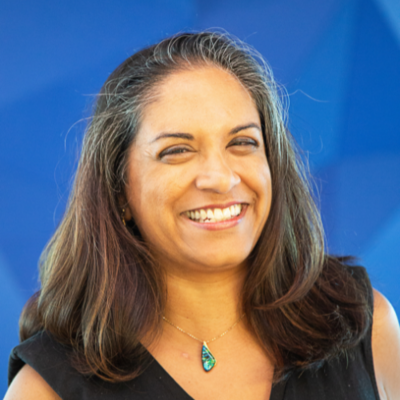
Natasha Udu-gama
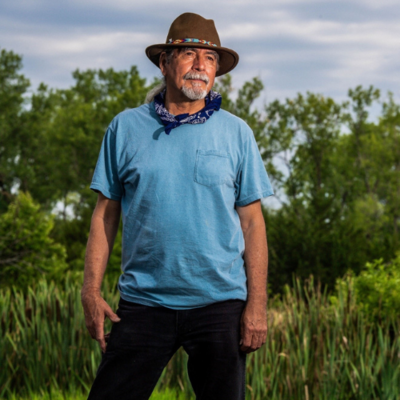
Daniel Wildcat
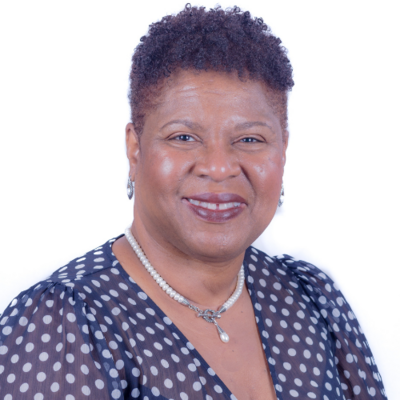
Angela M. Chalk
Summary
The climate crisis can feel distant - like it’s someone else’s problem - until your town is flooded, your home is damaged by storms, you're struggling to pay electricity bills as the summers get hotter. Figuring out the specifics of how a region is vulnerable to climate impacts can be the difference between adaptation or disaster, especially for communities that don’t have a lot of climate or environmental expertise among their members.
“Community science is defined as communities and scientists working together to address community priorities related to climate change, natural hazards, natural resources, environmental health, pollution, sustainability and resilience,” says Natasha Udu-gama, Director of American Geophysical Union Thriving Earth Exchange, a global community science program that connects communities with scientists.
Natasha Udu-gama’s family is from Sri Lanka, which was terribly impacted by the 2004 tsunami, the deadliest natural disaster in the 21st century. Udu-gama was living in the United States at the time but knew she had the skills that her home country needed, “I decided to leave my paying job here in the United States to find opportunities there in 2005.” Not knowing where to start, she took out a pile of business cards, “ I took the first card off, and it was the executive director of one of Sri Lanka's largest community based organizations, and I reached out to him. And literally five minutes later, I kid you not, he wrote me back and he said, you know, we need people like you.” Udu-gama’s disaster recovery work in Sri Lanka informed her later work with Thriving Earth Exchange.
The 7th Ward in New Orleans was one of the hardest hit areas during Hurricane Katrina, and the area is still affected today, nearly 20 years later. Angela Chalk is Executive Director at Healthy Community Services, a non-profit based in the 7th Ward. Chalk is also a Community Science Fellow with the Thriving Earth Exchange. She says that every community science project begins by focusing on that community’s specific concerns, “For us, it was the lack of trees and the extreme heat that we were experiencing,” says Chalk.
“We were able to come up with the project of reforesting a 4x2 square block area to measure surface temperature and in planting trees. And so to date we've planted 740 trees, 30 of which went in yesterday. And another 200 to go in later this planting season. And as a result of that, we're able to issue real time heat alerts through a weather station that's located in the 7th Ward,” says Chalk.
Daniel Wildcat is a Professor at Haskell Indian Nations University. He uses the word “indigenuity” a lot. This mashup between “indigenous” and “ingenuity” is “basically taking indigenous knowledge and wisdom and applying it to solve very contemporary problems.” Wildcat says. “When you talk about indigenous cultures, indigenous knowledge systems, some people think that's all about the past. No, these are living systems. These are living intellectual systems. They're spiritually connected to all of life that surrounds us.”
One example of a successful community science project comes from the Northeast Oklahoma community of Miami. When flood waters rise at the site of an abandoned mine there, , they bring toxic waste with them. Graycen Wheeler, a reporter at KOSU, says, “Before mining stopped in the 1960s, the mines generated massive piles of chat—toxic leftover gravel that contains lots of heavy metals. These toxic piles look like sand dunes, and can be as big as small mountains, and they’re all over the county. The Federal Emergency Management Agency charts floodplains across the country, but no one had ever layered those on top of a map of the chat piles.” As part of a Thriving Earth Exchange project, local officials and scientists created a a more comprehensive map.It allowed them to see where floodwaters may carry toxic waste and warn residents who could be in danger.
The effects of community science projects go beyond just the projects themselves. “I've seen my community come together, not just the legacy residents, the residents that are new and moving into the community and having a true sense of community.” says Angela Chalk. Chalk also says, “We no longer want to be studied or extracted. We want to work with scientists. to understand our community so that we can come up with real solutions.”
This episode was produced in collaboration with the American Geophysical Union (AGU) and features a segment from Contributing Producer Graycen Wheeler.
Episode Highlights
3:37 Natasha Udu-gama on going to work in Sri Lanka after the 2004 tsunami
7:38 Angela Chalk on her work in the 7th Ward
11:50 Daniel Wildcat on the term: Indigenuity
15:14 Angela Chalk on how racism shapes communities
19:27 Graycen Wheeler piece on toxic flooding in Miami, Oklahoma
24:16 Natasha Udu-gama on community science project her organization made possible
35:45 Angela Chalk on how her community has come together
44:33 Daniel Wildcat on how technology and past harms
Resources From This Episode (3)
Full Transcript
Note: Transcripts are generated using a combination of automated software and human transcribers and may contain errors. Please check the actual audio before quoting it.
Greg Dalton: I’m Greg Dalton.
Ariana Brocious: I’m Ariana Brocious.
Greg Dalton: And this is Climate One.
The climate crisis can feel distant — like it’s someone else’s problem in another place - until your town is flooded, your home is damaged by storms, you're struggling to pay electricity bills as the summers get hotter. My rural community is trying to get ahead of the curve now as people try to understand how their wells really work and when they might run dry. That’s one example of building local resilience before disaster strikes.
Ariana Brocious: And figuring out the specifics of how your region is vulnerable to climate impacts is super important, especially for communities that don’t have a lot of climate or environmental expertise among their members. For example, if I don’t know how to determine if a flood plain near my house is going to encroach with global warming, who do I ask? That's why we’re excited to focus this episode on community science.
Greg Dalton: Community science is not to be confused with citizen science, which is basically when people collect and send data to scientists – like how much it rained in their backyard or how many birds they spotted on a walk. Citizen science is neat and valuable in its own right, because it can provide widespread, hyper-local data. But typically when people send in their numbers or their photos, that's the extent of their involvement.
Ariana Brocious: What we’re talking about today is community science, which is when community leaders work with scientists of all kinds – hydrologists, botanists, engineers, and others – on projects initiated and led by the local community.
Greg Dalton: Right and those local communities don’t have staff scientists. One group that helps facilitate community science programs worldwide is called Thriving Earth Exchange. They connect communities with scientists, and support them as they work together to tackle local challenges related to hazards, natural resources, and climate disruption.
Ariana Brocious: Thriving Earth Exchange is a program of the American Geophysical Union, or AGU. That’s a global community of more than a hundred thousand earth and space scientists. And this episode was produced in collaboration with AGU.
Greg Dalton: AGU is a big deal in this realm. To learn more about how community science works, I got together with three people who are practicing it on the ground: Natasha Udu-gama, Director of Thriving Earth Exchange, Dan Wildcat, a Professor at Haskell Indian Nations University and Angela Chalk, Executive Director at Healthy Community Services in New Orleans.
Ariana Brocious: We started talking about a natural disaster from about two decades ago… In 2004, an earthquake in the Indian Ocean caused a tsunami that hit several nations in Southeast Asia, Thailand, and Indonesia.
Greg Dalton: I remember watching horrifying video of people racing uphill to escape massive waves crashing into beachfront hotels. The tsunami killed 230,000 people and is considered the most deadly natural disaster in the 21st century.
Ariana Brocious: Natasha Udu-gama’s family is from Sri Lanka, which was terribly impacted by the tsunami. While Natasha was living in the United States at the time, she knew she had to get to Sri Lanka as soon as she could. She has a master’s degree in disaster management, she knew how to help.
Natasha Udu-gama: When the 2004 tsunami struck Sri Lanka, I was very much called to wanting to be of support to, you know, extended family back home, some, some in fact, who had lost their lives, uh, and wanting to give back to the country. So, uh, I decided to leave my paying job here in the United States to find opportunities there in 2005. And that was following a reconnaissance visit that I'd sort of instigated with Virginia Tech, and we went, we did a lot of trips, we met a lot of people, but we didn't necessarily get a project that we had anticipated getting, and so I sat back and kind of realized, you know, I, I really do want an opportunity to work there, but I didn't know how that was going to happen, so I had a pile of cards. I took the first card off, and it was the executive director of one of Sri Lanka's largest community based organizations, and I reached out to him. And literally five minutes later, I kid you not, he wrote me back and he said, you know, we need people like you. We'd really like you to come out and, um, you know, We'll send you a ticket.
Greg Dalton: Your homeland was calling you.
Natasha Udu-gama: That's right. That's right. So it was just like following this unction. And you know, the thing is, the, the ancient Arabic word for Sri Lanka is serendip. Um, so that's where the word serendipity comes from. And so I, I like to think that, you know, my work is serendipitous. I also feel like it's also fated.
Greg Dalton: Right, and so now your organization, Thriving Earth Exchange, connects communities with science and supports them together to tackle local challenges. Over 250 projects in 15 countries, but how does it actually work? You know, how does that, you know, how do you connect science with local communities?
Natasha Udu-gama: So community science is, and as per AGU, Thriving Earth Exchange, community science is defined as communities and scientists working together to address community priorities related to climate change, natural hazards, natural resources, environmental health, pollution, sustainability and resilience. So everything between the core of the earth and the surface of the sun and everything in between are what our over 350,000 members and affiliates in 147 countries are able to do. We connect communities who have these priorities to scientists who are interested in working with them to advance those community priorities so that they can develop feasible and impactful tools and solutions for those local places, for those neighborhoods, um, and really provide access to the science that they have never had the opportunity to have,or have not necessarily had the opportunity to work with hand in hand. Since 2015, we've had partnerships, what we call community serving organizations. So these are organizations like ICLEI, Local Governments for Sustainability, the International City and County Managers Association,and others who basically boast networks of cities, communities, neighborhood groups, then I would say in 2017, our connection with the Anthropocene Alliance has really helped us to, uh, exponentially support more marginalized, underserved communities. And since then, I would say our reputation of being able to support communities in a very authentic way. has really enabled more communities to come to us through word of mouth, which is exciting.
Greg Dalton: One of those communities is in New Orleans’ Seventh Ward. Angela Chalk is Executive Director at Healthy Community Services, a non-profit based there.
Ariana Brocious: The Seventh Ward was one of the places hardest hit by Hurricane Katrina, and the area is still affected today by consequences of the storm.
Greg Dalton: Angela is also a Community Science Fellow with the Thriving Earth Exchange – Natasha’s organization that pairs scientists with communities. I asked Angela what specific local needs she saw that prompted her to work with outside researchers.
Angela Chalk: Well, for us, it was the lack of trees and the extreme heat that we were experiencing long before the summer of 2023, in working with the researchers that I was connected with, Dr. Derek Van Burke of the University of Michigan and Dr. Amy Lesson of Dillard University, my alma mater. We were able to come up with the project of reforesting a 4x2 square block area to measure surface temperature and in planting trees. And so to date we've planted 740 trees, 30 of which went in yesterday. And another 200 to go in later this planting season. And as a result of that We're able to issue real time heat alerts through a weather station. That's located in the 7th Ward and for us to gather data, there are sensors that are strategically located within that research zone. As a result of that, also, we're able to leverage funds from other philanthropic organizations to be able to plant greater trees and greater size and diameter. What Dr. Van Berkel is doing at the University of Michigan is developing a tracking tool so that we can monitor the size of the trees, the species of trees, the rate of growth, and whether those trees are surviving or not. And Dr. Lesson works on the social aspect of, of what urban heat means to people,how we are working with each other and, and when it's, when it's hot, how do, how do folks do their daily essential activities? What does that mean for people with chronic diseases such as respiratory illness? And so what came out of that when we planted this second set of trees was right at COVID, is that residents in the neighborhood started saying to me, because I live in a neighborhood where people know each other for generations, they started noticing the calming effect that the trees had on them during the COVID epidemic when we were all, um, quarantined. And so, the benefits of trees are not only from the aspect of reducing, um, urban heat and increasing the canopy, but it's the social aspect of it. It's the aspect of it when we look at it with managing stormwater, how trees uptake water when we're planting native trees as opposed to just ornamental trees. And so community engagement was, was of the utmost important aspect of that because neighbors were able to learn more about native trees as opposed to just a tree. And so now everybody in my neighborhood is a tree expert. They can tell you the species of native trees that they want plant in front of their homes in the public right away. And when I tell you everybody is a native tree expert, they can tell you down to the, the, the growth of the tree, it's deciduous or evergreen, and most folks will now want the flowering trees, um, the Chinese Taiwan cherry, which we know that we're on the same parallel with those other countries. So they can go that, that far to tell you that we're on the same parallel with other countries, that these trees will grow specifically in our area and are adapted to our climate. and that only comes from being engaged with residents to provide that community education.
Greg Dalton: Lot to those trees. Cooling, calming and all sorts of benefits of those trees and monitoring them, not just like not like planted and they're done. you have to like keep them going.
Angela Chalk: And we're able to hire folks from Workforce development and then local contractors, African American contractors that are from the neighborhood to be able to plant those trees. So we're creating a circular economy as well as reducing the urban heat out in effect.
Greg Dalton: Our third guest in this conversation is Dan Wildcat, a Professor at Haskell Indian Nations University in Lawrence, Kansas. He helped me understand a term that I hadn’t heard before – Indi-gen-uity.
Dan Wildcat: Indigenuity is, is, has a lot of pieces, but the simplistic description of it is it's basically taking indigenous knowledge and wisdom and applying it to solve very contemporary problems, modern problems. It disabuses people of the fact that, uh, when you talk about indigenous cultures, indigenous knowledge systems. Some people think that's all about the past. No, these are living systems. These are living intellectual systems. They're spiritually connected to all of life that surrounds us, And we live in the age of the Anthropocene. So far, human-centered Earth has not been very good for the balance of non-human life on this planet. And I think the advantage of indigenous knowledges is they are decidedly non anthropocentric. So for me, I don't think of a wild cat as an animal, I think of it as a relative. I carry that name. That is imbibed in many native cultures where people's clans are identified with the animals, the plants, features of the natural world that they share. Not romanticism, that's indigenous realism. In fact, it's more consistent with modern science than a lot of other views of what people think about things. We're all related. So, indigenuity is a way of thinking about how we address the problems that we face now, remembering that it's not all about us. We have a lot of teachers out there, that water, the land, the air, the plants and the animals, and Zoya Ha traditions, those are relatives, and they are teachers. those are features of indigenuity that I think are, are desperately needed today. We're talking a lot, you know, in community science, those of us that are working in the area of global climate change, about finding a new lens. A way in which we can understand the world. And the beautiful part of indigenuity is, it is by its very nature non hegemonic. There is no indigenous view per se. There's a Choctaw view. There's a Seminole view. There's a Haudenosaunee view. There's a Miwok view.
Greg Dalton: You're not monoliths,
Dan Wildcat: Right. Because, because the knowledges are shaped by that unique relationship between a people and a place. So Indigeneuity would suggest to us that if we want to address climate change, don't be looking for that one magic pill or bullet. We're going to have to apply different solutions in different places because we all know climate change will manifest itself differently in different places.
Greg Dalton: Yeah, it is, and it's, it's unequal, it's unfair in lots of ways. You know, the global north certainly, uh, you know, where trees are, are not, it, is, is, is related directly to redlining where banks lend and didn't lend.
Angela Chalk: Yeah. And, and as we talk about that, um, you know, no one likes to discuss the elephant in the room about racism and it's not. unheard of for, as you speak about with redlining, about why communities are the way they are. And in my community,we were on what was once swampy land, but it was undesirable land. It was cheap land for people to be able to purchase. and currently it's by design, in my opinion, that we don't have these tree lined avenues that perhaps the more affluent sections of New Orleans did. And we once did. Along the North Claiborne Avenue corridor, we once had thriving oak trees similar to what we all see on St. Charles Avenue. But because of urban development, the interstate system, the I-10 system came through and clearly wiped that out at, um, during the, the, the, I can remember during the 60s, um, when, when the interstate came through and just moved people out. this North Claiborne Avenue corridor was a bustling African American business corridor. It's, it's cut off. It remains cut off. And now how people talk about taking the I-10 down, but what do we do now? there are things that we can do. And that's, that's involving the community to say, hey, this is what we want in our community now. based on the atmosphere and the climate that we're dealing with now. And we use the analogy when people don't want to talk about racism and environmental justice. We have to talk about it because folks say that, oh, it's so traumatizing. Well, it's traumatizing to the people that live there because we live it every day. But it's something that has to be said because without the friction to move it forward, to change. If you have a flat tire, if you don't continue, if you continue on with the friction and ignoring it, you're going to continue with a flat tire. But when we,
Greg Dalton: Friction is necessary for movement and
Angela Chalk: Yeah, friction is necessary for movement and change. And so as a, as a black woman growing up in a black community, we have to have that friction to bring attention in order for there to be change. If what we say is true about all of us being equal, and actually in my mind, I don't want equality. I want equity. And there's a difference. And so people need to understand the difference between, um, equality and equity so that we all can thrive and be, and have a just life that's promised to us we are promised, endowed by certain in unalienable rights that all men are created equal. Then we want this in our communities and, um, it particularly now, and I can only speak from the black perspective. Black communities now realize, especially with the trillions of dollars of federal investments, that we're the ones that are in the driver's seat that can, that can dictate the way our communities are changing. And we no longer want to be studied or extracted. We want to work with scientists. to understand our community so that we can come up with real solutions for our community. So, no longer are the days when you come in and extract information and distract us from the real issues. We want to be at the table and working with scientists to resolve our issues, and that's what Thriving Earth has done for my community.
Greg Dalton: You’re listening to a Climate One conversation about combining community knowledge with science. If you missed a previous episode, or want to hear more of Climate One’s empowering conversations, subscribe to our podcast wherever you get your pods.
Ariana Brocious: Please help us get people talking more about climate by giving us a rating or review. You can also help by sending a link to this episode to a friend.
Greg Dalton: Coming up, why scientists need the general public to help them understand the value of their work.
Dan Wildcat: No one's ever told a geologist or a person who's working with plate tectonics, you know, it might help if you knew something about the people that experienced those earthquakes.
Greg Dalton: That’s up next, when Climate One continues.
This is Climate One. I’m Greg Dalton
Ariana Brocious: And I’m Ariana Brocious.
Greg Dalton: It’s great to talk about community science at a high level, and it also helps to get a sense of what this looks like on the ground. For that, we have a story from a local reporter in Oklahoma.
Ariana Brocious: Climate-fueled flooding is becoming more common as warmer air increases the intensity and duration of storms. And the impacts can be compounded. When flood waters rise in the Northeast Oklahoma community of Miami, they bring toxic waste with them. Graycen Wheeler, a reporter at KOSU, has this story of how community science is helping locals raise awareness about harmful mining waste.
AMBI UP WITH LAUGHTER AND CREEK NOISE
GW: Rebecca Jim is meeting with members of her community – in the middle of Tar Creek.
JIM: So what do you think? We did a thing together.
GW: Standing in the water as it winds between a disc golf course and a nursing home, Jim and her companions are soaking up the natural beauty of autumn in Miami. But a threat looms ever present. It comes from the creek.
[bring up creek ambi]
GW: This part of northeastern Oklahoma is dotted with old lead and zinc mines, which put heavy metals and other toxic materials into nearby streams. But the health risks aren’t confined to those who visit the creek itself. When Tar Creek floods, it spreads lead and other heavy metals across nearby communities.
JIM: They do not just get a flood. They get a toxic flood.
GW: Jim is the co-founder and executive director of LEAD Agency in Miami. The group educates the communities around Tar Creek about its toxic history and advocates for a safer future.
GW: Before mining stopped in the 1960s, the mines generated massive piles of chat—toxic leftover gravel that contains lots of heavy metals. These toxic piles look like sand dunes, and can be as big as small mountains, and they’re ALL over the county.
And it turns out they sit in the same floodplains as Miami’s homes, schools and businesses.
JIM: We knew Tar Creek had metals in it, but no one had imagined the amount of stuff coming down from the chat piles.
The Federal Emergency Management Agency charts floodplains across the country, but no one had ever layered those on top of a map of the chat piles.
JIM: We wanted a map for the citizens in Miami to understand their relationship with water. Where is it? And when can it harm me?
To do that, LEAD Agency partnered with researchers through a program called Thriving Earth Exchange that pairs scientists with local communities. One of those scientists is Jessica Tran.
TRAN: I'll be honest, like, it's been really a joyful and collaborative process. And like, I didn't expect that to happen through this work.
GW: Tar Creek is a Superfund site—an area so contaminated with hazardous materials that the EPA has earmarked it for investigation and clean-up.
Since cleanup began in the 1980s, state and tribal agencies have spent over $300 million removing toxic materials from hundreds of properties in the County.
But Tran says the new map shows that many cleaned-up properties are at risk for REcontamination.
TRAN: If you go into the map, and you look at how the floodplain overlaps with chat piles, it kind of tells the story that like, if it floods, it can carry waste from the chat back into yards and homes, even of places that have been cleaned up already
GW: Now that they know about that risk, The Indian Health Service has been using the map to identify homes with Indigenous children that have drinking wells near the Superfund site.
JIM: As soon as we identify which houses to knock on the door, they can go right away and determine if those people are at risk of lead poisoning from their wells. (25 jim-door-knock.wav)
Jim says the IHS has funding to hook those families up to the rural water supply and get them off contaminated wells.
JIM: If we can save the health of individuals into the future by using the map, I'm really pleased to be able to do that. (8 jim-save-health.wav)
Jessica Tran says Rebecca Jim has found plenty of ways to wield the map.
TRAN: Every time I'm on a phone call with Rebecca, she's always like, ‘Jessica, I need to tell you a story about like, how the maps been used this week.’ There's always something new with it going on.
Right now, LEAD Agency is using the map to protect Miami residents from what they see as another danger. Downstream of Miami at Grand Lake, higher water levels mean more tourism and more hydroelectric power.
Regulators are looking to increase the depth of Grand Lake when they relicense their dam before 2025. That will leave floodwater with nowhere to go but into the communities upstream, like Miami. And the water will bring toxic chat with it.
Jim says the map has helped show federal officials they need to consider a closer look at the possible exposure for upstream communities.
JIM: We wouldn't have had a chance to talk with them without the map. That got their attention—it got everybody's attention. (7 jim-got-attention.wav)
GW: And with climate-fueled flooding on the rise, people here need all the information they can get. For Climate One, I’m Graycen Wheeler.
Greg Dalton: Let's get back to my conversation with Natasha Udu-gama, Daniel Wildcat, and Angela Chalk, three people bringing science into communities to help them take control of their own climate futures.
Natasha shared another example of how her organization gives local people direct access to scientists who can help protect their neighborhoods and personal health.
Natasha Udu-gama: Back in 2017, in Evanston, Illinois, the environmental justice community just outside of the waste transfer station in Evanston, Illinois, was very concerned about the impacts that waste transfer station was having on the health of the community. A lot of those mostly black poor underserved areas of that of Evanston were basically suffering from asthma and other health effects of the waste transfer station. And so they really banded together. Luckily, they had a great sustainability coordinator who was very open, and they had an environmental justice committee in that community in Evanston that was very active. So they were actually part of the vetting of the scientists that we put forward. I recommended some scientists and they said, okay, we'd love to be able to be part of the selection. Because of that, they had even more support from the entire community. And eventually they were able to set up air quality monitors around the waste transfer station. The scientists who were selected to be on this project were eventually selected by the mayor of Evanston to be on the climate committee. and they were able to find subsequent funding, where they were able to actually keep those air quality monitors going over time. And the scientists have built that trusting relationship. So just as Dan was saying about, you know, having these solutions really, really fast. focused on different communities. That is what Thriving Earth Exchange is helping to do. And we're not just trying to do this in a way that just does one offs. We try to as much as possible, document every single process, and we make sure that, you know, all these processes are online and are available to other communities so that they can take a look at what are those solutions that are out there, what has been developed by other communities so that they can replicate, adapt it as necessary and then make it and tailor it to their community.
Greg Dalton: Dan, in the projects that Natasha and Angela describe, it sounds like while there's community leadership, you know, the scientists come from outside. And what's your view of these outside experts and how they can kind of really connect in non arrogant way?
Dan Wildcat: Well, I think we've got to break this notion of extractive, you know, activities that go on often by scientists. And I think that that's beginning to happen now. It's a generational thing. We're past this notion of, of scientists coming in and looking at indigenous people as research subjects. Our project, which is Convergent Sciences, we look at the community members we are working with as the co creators of the science that we are producing. They're not research subjects. They're on equal footing with the scientists, the physical scientists, the university trained scientists. So I think what's going on now, and
Greg Dalton: But that, that's just, that takes a lot of humility for some fancy PhD person, right?
Dan Wildcat: You are right. Now that's, that's something that we've got to model. We have to embody that, and so, uh, you know, I'm lucky to share the podium here with, with two strong women, who, although they're very strong, they embody a humility in their work, and I mean, I think this is what we need, is to quit promoting this notion that the scientist has to know it all, can never admit they don't have an answer, and instead really, developing some tools to learn how to do engagement. That work is going on right now. So, uh, my good friend James Ratlingleaf, he's doing a thing with some other Native people programming called Creating Ethical Space. I'm working with some colleagues, like Dr. Julie Maldonado and, and Eros Petrovich from Haskell and a number of, of, of Indigenous scholars doing a training called A New Lens for Engagement, we believe that physical scientists now should all be taking training in how to engage with the people of the places where they are doing their work. This is new. No one's ever told a geologist or a, a person who's working with plate tectonics, you know, you might help if you knew something about the people that experienced those earthquakes, you try to predict, and,
Angela Chalk: I might need to take that. I might need to lead that course. And if anyone wants to start that–
Dan Wildcat: This is a paradigm shift. You're right, this is not easy work, because who's going to pay a scientist to go out and, and, and meet community members and, and break bread with them and everything, that's not part of their job. Well, it's part of their job now.
Angela Chalk: Yeah, it is.
Dan Wildcat: I think that's what community science is about. You've got to know your community. You've got to engage with the community. And that check the box idea, we were talking about
Angela Chalk: That check the box is over.
Dan Wildcat: That's gone. That's not going to work anymore. You can't call us up and say, Hey, we've got this big grant, a couple million dollars. Would you like to be our partner? And we're going like, we don't know you. Who are you?
Greg Dalton: Angela, what do you see in terms of arrogance and humility of people coming in to say, yeah, I mean, Seventh Ward, New Orleans, working class neighborhood?
Angela: Oh, I, I experienced it just recently because of the, the, the summer of 23, the high heat indices. And, you know, I've been doing this research now six years. And so, Someone offered me 100,000 for our baseline data and being a small community based organization, they thought that 100,000 was a lot of money to me. And it was insulting. And I told them that is insulting. So you, well, yeah. So it's like, well, I'll give you 125,000. I'm like, take your 125,000.
Dan Wildcat: Whoa.
Angela: And go somewhere else with it because if I, if you're offering me 125, 000 that means that you can get 10 million somewhere else. And so you have to, working in community, you have to know who you are and whose you are. And I work with, I'm, I'm working with fantastic researchers who they have skills, I have skills, and together we make this a powerful research project. And so I could not even begin to entertain. the thought of taking a monetary, um, settlement without even first consulting them. And then first of all, 125,000 was insulting to me to think that, you know, you can waive that check in front of me and say, Hey, this is a lot for you. You ought to take this. So I don't know. I didn't know whether to be insulted as a black woman or to be insulted as a scholar that you thought that 125,000 for my research was something that I should be grateful for. And this is what's occurring in communities of color. So if you're doing it to me, a woman that's educated, what would you do to someone at a community level, if it was the Boy Scouts or the Girl Scouts that were doing this? And so I told him, take his 125,000, and y'all know what else I said. I, again, I live in a community in which I serve. And so it wasn't about, it wasn't about me. It's about the people that live in my community.
Greg Dalton: Even well intended and well educated people can come in with presumptions. Uh, Natasha, you went to a small fishing village in Bangladesh, uh, to talk about risks, and you went in there with some presumptions about, uh, what risk was for them that was different than the people on the ground, so share that.
Natasha Udu-gama: that. Yes, that's a really good point. Um, yes, when I went and I did my PhD research in a small fishing village in Cox's Bazaar in Bangladesh, you know, I was looking, I was trying to understand, like, how did those communities understand, early warning systems, especially as it related to cyclones that were very frequent in Bangladesh. And uh, I remember asking them the question, so, you know, what are the risks here? You know, and their responses really took me by surprise. I remember just being flabbergasted that it was health, that access to, you know, education, we don't, you know, we're used to being flooded all the time. You know, we have, you know, indigenous ways of working on, you know, supporting our community. And Bangladeshi communities are often, um, they, they, they have all these external consultants coming in and they tell them, you know, we need to build this mound and this is where you're going to go should there be flooding. Um, so yes, I was, um, that was, that, that was definitely a moment in my career where I was like, okay, you know, this is really, you know, and, and they saw me, because I was also a brown skinned person, as being, like, one of them. And they were kind of shocked that, you know, I was even making this assumption that, you know, the risk was, uh, anything but what they were saying, you know? Um, and then also just, you know, making sure that you are in the room. with the right people. And I was told by my Bangladeshi colleagues, you know, like you need to really make sure that, you know, you're not going to get the responses of women if you're in a mixed group because they will not speak up. So, you know, having, you know, really getting to know the community before you try to, you know, you know, Even ask any questions and just understand a little bit about those communities, so that you can understand, like, where they're coming from and what, what sort of knowledge they already have. I mean, it was, it was a pivotal moment for sure. and that's, that's where the funders really need to understand that it takes time to build these relationships. We can't just get funding to do work with communities and expect to have, you know, the results, um, in a year or two.
Ariana Brocious: You're listening to a conversation about community science. This is Climate One. Coming up, big changes often start with little steps.
Angela Chalk: Nothing is going to happen overnight in grand scale. So start small. And build incrementally.
Ariana Brocious: That’s up next, when Climate One continues.
This is Climate One. I’m Ariana Brocious.
We hear so much about the climate crisis being fought on the national or international levels — led by politicians and scientists in big ticket institutions. But all this hour, we've been talking with people who are on the ground, in cities and towns, partnering with community members to address climate issues on the local level.
Let’s get back to Greg’s conversation with Natasha Udu-gama, Director of the Thriving Earth Exchange, Daniel Wildcat, Professor at Haskell Indian Nations University, and Angela Chalk, Executive Director at Healthy Community Services in New Orleans.
Angela has been working in community based projects for many years and says, bit by bit, that work has shaped a larger conversation.
Angela Chalk: I've seen my community come together, not just the legacy residents, but for the residents that are, that are new and moving into the community and having a true sense of community. People are talking more with each other around the common issues that we have of heat, of urban flooding. And, um, the lack of access to food. So all of those things come together at the intersection of public health and climate health. And my background is in communications and public health. And when I first started with those disciplines, everyone was like, well, those disciplines don't go together. Well, yes, they do. Because unless I'm able to effectively communicate with someone and meeting someone where they are, I can't begin to tell them about the social determinants of health in a language that, that they can relate to. It goes back to the investment being made in to me through education to be able to come back to my community, to be able to explain that in a way that people get it. we had high, um, incidents of chronic respiratory diseases, gun violence. But these trees are giving folks a sense of community, and we know that communities with green spaces have less violence. So I am waiting to see when the social benefits, the results are going to be from this research. Now, had someone told me that I needed to wait at least 10 years because trees grow slow, I might have said maybe this is not the project for, for us, but it was the, it was the need of the community.
Greg Dalton: Can you get people to think that that tree is a relative, like, like Dan would say?
Angela Chalk: Yes, absolutely. Because folks are beginning to understand the benefits of trees. Um, and they're, they're watching the trees as they grow. So when there's something that's going on with the trees, I get the call and I have one, one of my elders who called me at midnight. I don't know why she was up at midnight. But called to tell me that one of the gentlemen at the local bars was dancing with the tree. And so I was like, I will handle that in the morning.
Greg Dalton: It's taking the relative thing a little far, yeah, right?
Angela Chalk: People are taking ownership in realizing that these trees are now a part of our community. And then the ecoservice benefits that we're seeing from having the trees in our neighborhood is giving us a greater ecosystems benefit return.
Greg Dalton: That's a new tree hugger kind of thing. Natasha, you know, the culture of science and academia is still publish or perish. There's a lot of pressure, you know, and I've heard you talk about, there's the industry path and the academic path for PhDs. So how do you balance that pressure to, you know, to get published, which is kind of like, you know, sucking data out, offering Angela money or, you know, it's like, so how do they balance that? Because there's a lot of pressure in academia these days.
Natasha Udu-gama: There is, and I would say there's a lot of change happening in academia. I think in the last 10 years that, you know, Thriving Earth Exchange has been around, this is our 10th anniversary. Um, AGU has made a lot of strides in, you know, really building out the community science space. We now have something called the Community Science Exchange, which is an opportunity for scientists, community leaders, and others to get together on an online space. There's a journal, community science journal where it's open access, um, and basically providing the opportunities for more academics, um, and students to get, uh, rewarded and recognized for the kind of work that they're doing with communities. There's even an opportunity there to share resources on that hub. Um, so we're, you know, more and more trying to get communities themselves, um, as they're interested to share resources.
Greg Dalton: But you go for that tenure track position. They're not going to say like, Oh, did you talk to the people in that community that you got the data from? They're going to be like, where's your prestigious journal publication?
Natasha Udu-gama: Right. And, and. It's slow, but there are a lot of different organizations that are working on this, even including Pew. Pew has a whole, like, burgeoning sort of group that is working to really understand what are the opportunities to incentivize this work. There are, like, professor of practice now, like, um, my soon-to-be-former boss, Raj Pandya, will be a professor of practice. And so, and those types of professors will basically be rewarded more. for the work that they're doing with communities, rather than um, the, the number of publications, the type of publications
Greg Dalton: Right, right. So, Dan, how should a scientist coming into a community from the outside work with the local knowledge? Especially if they're not trying to do that.
Dan Wildcat: Well, here's what I would suggest. I think that we need to encourage scientists today to create those spaces within their institutions where they are welcoming in. community members to be a part of that space for science, for research. Now, here's the main challenges. You're right. We still have very much this kind of publish and perish kind of notion. I think one way to address that, and the community scientists are doing it, I try to do it in my work. I still publish, but I'm not writing to scientists. I want writing to community members. I try to write my books so that my aunties, my uncles, my nieces, my nephews, and when my granddaughter gets to be about 13 or 14, she could read my book and understand what I'm saying because it's important. I think the big shift right now in science is scientists are beginning to understand those days of just you doing your science and all you do is talk to other scientists. I think that's really not being seen as tremendously valuable when we're facing the kind of imminent existential crises on this planet we're facing now. We don't need people to retreat into their disciplinary silos. We don't need people thinking in boxes. I've been advocating, along with a lot of scientists, that maybe it's time to listen to indigenous people. They never thought in boxes, and we never worked in silos, and most of your neighbors don't think that way either.
Greg Dalton: Science and technologies that science has spawned have a long history of harming vulnerable communities, being extractive and using certain communities as guinea pigs. I'd like to ask each of you how science can undo past harms without causing new unforeseen ones. Angela.
Angela Chalk: Oh, you're going to go to me first on that one. Okay, so the first thing that I would say is, um, as everyone else has said, you want to work with communities and be respectful. That's the number one thing, being respectful and building true relationships with folks. And if there's something that you cannot do, then just simply say that. People can accept the truth rather than you just habitually lying about the issue. Because if I'm expecting you to do something and you can't do it, just come to me and say you can't do it rather than leading me on because that is the worst kind of way to think that you're going to get something done and then come back to me and say, Hey, I have this proposal.You want to be on it? Well, no, I want to be in on a decision to see if this is a good fit for us. So being respectful
Greg Dalton: uh, pull you in as a,
Angela Chalk: yeah, stop. There's a community engagement spectrum, and you need to look at that to see where you're at. Are you tokenizing me? Are you placating to me? Or are you really want me to be involved with this? And so that starts with respect and mutual respect and realizing that all relationships don't have to last for a lifetime. They can have a beginning and an end point. We, I mean, I don't only want to be with you on this project. I may decide I don't really like your technique, but for the benefit of my community, this was good. But later on, if you call me up, I'm good. Being respectful is the first thing that I would say.
Greg Dalton: And Dan, how about you? You know, science can undo past harms without causing new ones.
Dan Wildcat: I think we've misvalued technology. We treat technology as if it's, it's, it's a variable that's going to solve everything. And what we've seen is that what has the age of the Anthropocene taught us? That most of our technologies have unintended and latent consequences we weren't smart enough to see. I'm not anti-technology. Let's revalue it. So I came up with an algorithm several years ago and I said, well, what technology should be equal to is the three Cs over E: Community. Culture, Communication over Environment. You should always have a positive value. If that community is strengthened, communication is strengthened, and culture is strengthened in that relationship between a people and a place, that's good technology. I can point to a number of technologies, as everyone in this room can, that have been very destructive to people's culture, their community, and don't we all know about the damage of what's happened to human communication in the age of the internet. Bad actors can make bad things happen.
Greg Dalton: Yeah, the internet, I was a reporter at the early days of the internet. It was supposed to democratize all sorts of things in communication, and it's now kind of controlled by a powerful few. Natasha, how can science, you know, advance while undoing past harms?
Natasha Udu-gama: Well, interestingly enough, we were talking about publish or perish, right? My PhD thesis was called Partner or Perish. So I think it's really important that we partner, and we partner authentically. So I think that's part of decolonizing science is really having as Angela was also talking about these really trusting relationships, you know, and having deep partnerships, really getting to know people connecting authentically. I mean, one of the things that has helped me in my career is making true authentic connections with people, you know, and I think, like, really taking the time to really understand, you know, the communities that you are working with, the people, the individuals themselves, where they're coming from, their context, their knowledge. And I think we're in a new era right after the pandemic, like, you know, there, there's been changes in the nature of connecting with people. And what does that mean for the future and how can we build those authentic connections and make sure that they are, um, sustained over time.
Greg Dalton: Yeah, I think this is really important in the climate conversation because global warming often devalues the local. It's like, oh, we got a, you know, this big scale. If it doesn't scale, it's meaningless. And I think that, you know, that old bumper sticker there, you know, think global, act locally kind of. I think we've got to be revived because the the global warming conversation pulls us away to this macro level that I think it gets us away from, from where we are and the people closest to us. As we wrap up, whether I'm a scientist or not, how can I get involved in working to solve environmental problems in my community? Dan?
Dan Wildcat: Yeah, okay, so the first thing you do is, start where you live, Build a neighborhood. Know your neighbors, so you can talk to them about what you can do to improve the air quality, the land quality, reduce waste. Improve your carbon footprint, reduce it. These are community issues, they're place issues, and I think there's good work to be done there. So, start by, if you don't know your neighbors, even if you're in an apartment building, Knock on the door and say, hey, you want to have coffee sometime? Let's just visit. Let's get to know each other. I think the biggest enemy we have right now to community science is the fact that increasing numbers of people live in anonymity in very large urban areas and folks, we can't afford to be anonymous anymore. We need to know our neighbors.
Greg Dalton: if you have an induction cooktop, invite people to come over and see how cool your induction cooktop is
Dan Wildcat: Yeah, there you go. Yep.
Greg Dalton: It cleans up the air. Angela, what can people do?
Angela: Well, I live in a neighborhood where people know me now as the tree lady. So, I would just have to echo that. But, um, be incremental in change, uh, because nothing is going to happen overnight in grand scale. So start small. And build incrementally. And that's, that has been the part of the success for Healthy Community Services by realizing that everyone has a role to play, whether you're a homeowner, a renter, um, black, white, and my neighborhood is changing because we're, we're getting, um, more of a Hispanic population now as a result of the changes from Hurricane Katrina and gentrification. And so we, as a community, have to adjust and realize that everyone is involved in this issue. But most importantly, listen to young people and bring them together with the elders so that the technology and the wisdom can come together.
Greg Dalton: Get the young people off their screens and with the elders. I like that. Natasha, Dan and Angela, thank you so much for sharing your insights here on Climate One.
Dan Wildcat: Thank you.
Greg Dalton: On this Climate One... We’ve been talking about how communities can work with scientists to help more effectively address the climate crisis.
Climate One’s empowering conversations connect all aspects of the climate emergency.
Ariana Brocious: To hear more, subscribe wherever you get your pods. Talking about climate can be hard — and it’s critical to address the transitions we need to make in all parts of society. Please help us get people talking more about climate by giving us a rating or review. You can do it right now on your device. You can also help by sending a link to this episode to a friend.
Greg Dalton: Brad Marshland is our senior producer; Our managing director is Jenny Park. Ariana Brocious is co-host, editor and producer. Austin Colón is producer and editor. Megan Biscieglia is our production manager. Wency Shaida is our development manager, Ben Testani is our communications manager. Our theme music was composed by George Young. Gloria Duffy and Philip Yun are co CEOs of The Commonwealth Club World Affairs, the nonprofit and nonpartisan forum where our program originates. I’m Greg Dalton.
